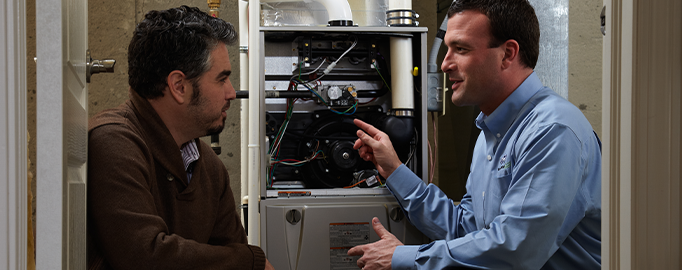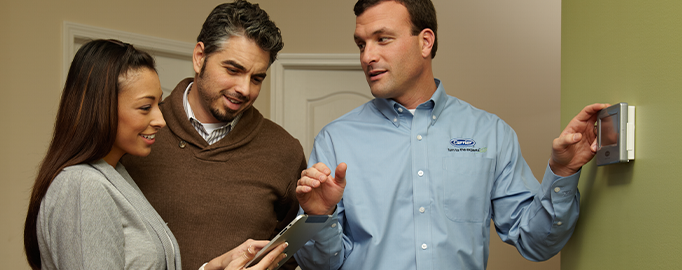HOW BELOW-FREEZING TEMPERATURES AFFECT FURNACES IN INDIANA

Indiana winters can be harsh, with temperatures often plunging well below freezing. These frigid conditions pose unique challenges for homeowners, particularly concerning the performance and reliability of their furnaces. Understanding how below-freezing temperatures affect furnaces is crucial for maintaining warmth and comfort during the year’s coldest months.
Increased Demand and Strain
As temperatures drop, the demand for heat rises significantly. Indiana’s Furnaces must run longer and more frequently to maintain a comfortable indoor temperature. This increased workload can strain the heating system considerably, leading to wear and tear. Components such as the blower motor, heat exchanger, and ignition system may experience accelerated deterioration, increasing the likelihood of malfunctions and breakdowns.
Efficiency Reduction
Furnaces are designed to operate efficiently within a certain temperature range. The furnace’s efficiency can decrease when the outdoor temperature falls below freezing. Cold air infiltrating the home can make it harder for the furnace to maintain the desired indoor temperature, causing it to work harder and use more energy. Additionally, older furnaces may struggle more in extreme cold, further reducing their efficiency and driving up heating costs.
Frozen Pipes and Components
Extreme cold can cause various components of a furnace to freeze. One common issue is the freezing of the condensate line in high-efficiency furnaces. When the condensate line freezes, it can block condensation drainage, leading to a furnace shutdown to prevent water damage. Moreover, frozen pipes supplying fuel or air to the furnace can impede its operation, potentially causing the system to fail when needed most.
Increased Risk of Carbon Monoxide Leaks
As furnaces work harder in below-freezing temperatures, the risk of carbon monoxide (CO) leaks can increase. Heat exchangers can develop cracks under stress, allowing CO to seep into the home’s air supply. This is particularly dangerous because carbon monoxide is a colorless, odorless gas that can cause serious health issues or even death. Regular maintenance and inspections are essential to ensure the furnace operates safely, especially during winter months.
Preventative Measures and Maintenance
Regular maintenance is crucial to mitigate the impact of below-freezing temperatures on furnaces. Homeowners should schedule annual inspections and tune-ups before the onset of winter. During these check-ups, technicians can identify and address potential issues, such as worn-out components, condensate line blockages, and heat exchanger cracks. Additionally, regularly replacing air filters can help maintain airflow and efficiency.
Homeowners can also take preventative measures to protect their furnaces. Insulating pipes and the condensate line can prevent freezing. Sealing drafts and improving home insulation can reduce the workload on the furnace by keeping cold air out and warm air in. Installing a programmable thermostat can help manage the furnace’s operation more efficiently, reducing unnecessary strain.
Emergency Preparedness
Despite taking preventative measures, furnace failures can still occur. Being prepared for such emergencies is essential. Homeowners should have an emergency kit that includes space heaters, extra blankets, and other supplies to stay warm if the furnace goes out. Knowing the contact information of a reliable HVAC technician can expedite repairs and minimize downtime.
TIPS TO HELP PREVENT FURNACE REPAIRS

When winter brings its frigid chill, keeping your home warm and cozy becomes a top priority. Running your heater efficiently during these icy days ensures comfort while keeping energy costs manageable. Here are some practical tips to help you make the most of your heating system when the temperatures plummet.
1. Optimize Thermostat Settings
Setting your thermostat to the right temperature can balance comfort and energy savings. The U.S. Department of Energy suggests setting your thermostat to 68°F (20°C) while you’re awake and lowering it while you’re asleep or away from home. This setting keeps your home warm without overworking your heating system.
2. Use a Programmable Thermostat
A programmable thermostat can help you manage your heating needs more effectively. Set it to lower the temperature when you’re not home and increase it shortly before you return. Smart thermostats can learn your schedule and make adjustments automatically, ensuring a warm home without unnecessary energy use.
3. Seal Leaks and Insulate
Ensure your home is well-insulated and free from drafts. Check for air leaks around windows, doors, and ductwork, and seal them with weatherstripping or caulk. Proper insulation in your attic, walls, and floors can prevent heat from escaping, keeping your home warmer and reducing the workload on your heating system.
4. Use Curtains to Your Advantage
During the day, open curtains on south-facing windows to let in sunlight, which can naturally warm your home. Close the curtains at night to add an extra layer of insulation and keep the warmth inside. Heavy, insulated curtains can be particularly effective in preventing heat loss through windows.
5. Maintain Your Heating System
Regular maintenance is crucial for keeping your heating system running efficiently. Change or clean the air filter regularly, as a dirty filter can restrict airflow and reduce efficiency. Schedule annual maintenance with a professional to check for issues like the condition of the heat exchanger, gas pressure, and overall system performance.
6. Use Ceiling Fans
Ceiling fans aren’t just for summer. Set your ceiling fans to run clockwise at a low speed during the winter. This helps to circulate warm air that rises to the ceiling back down into the living space, improving comfort and reducing the need for additional heating.
7. Keep Vents and Registers Clear
Ensure that vents and registers are not blocked by furniture, curtains, or other obstructions. Blocked vents can restrict airflow and reduce the effectiveness of your heating system. Keeping paths clear allows warm air to circulate freely throughout your home.
8. Dress Warmly and Use Blankets
While not directly related to your heating system, dressing warmly and using blankets can help you feel more comfortable at lower thermostat settings. Layer your clothing and use warm, cozy blankets to stay warm without needing to crank up the heat.
9. Use Space Heaters Wisely
If you spend most of your time in one area of your home, using a space heater can be an efficient way to stay warm without heating the entire house. Make sure to use space heaters safely: keep them away from flammable materials, never leave them unattended, and ensure they have safety features like tip-over protection.
10. Close Doors to Unused Rooms
If you have rooms that are seldom used, close the doors to those spaces. This can help direct heat to the areas where you need it most, making your heating system more efficient and effective. Just make sure there’s adequate airflow to prevent any moisture buildup or mold growth in those closed-off areas.
11. Use Humidifiers
Dry air can make you feel colder, even at higher temperatures. Using a humidifier adds moisture to the air, making it feel warmer and more comfortable. Maintaining a humidity level between 30% and 50% can improve your comfort and reduce the need for higher thermostat settings.
By following these tips, you can run your heater more efficiently on really frigid days, keeping your home warm and cozy without skyrocketing energy bills. Remember, small adjustments can make a big difference in both comfort and cost savings. Stay warm and enjoy the winter season!
Homeowners Most Common Questions About FURNACE Repairs

No homeowner wants to call in a professional just to find out that they could have fixed or prevented the problem. It’s not often that a homeowner can fix their furnace. However, it’s a good idea to check through these commonly asked questions so you can gain an understanding of what the problem may be before calling for repair service.
How can I tell if my furnace is broken?
Signs of a malfunctioning furnace include no heat, strange noises (rattling, banging, or squealing), short cycling (turning on and off frequently), and poor air quality. Check the thermostat, air filter, and pilot light, and ensure vents and ducts are clean. If these steps don’t resolve the issue, consult a professional.
When should I replace my furnace?
Consider replacing your furnace if it is over 15-20 years old, requires frequent repairs, has rising energy bills, or no longer provides consistent heat. A professional can help assess whether repair or replacement is more cost-effective.
Why is my furnace making strange noises?
Strange noises indicate loose components, worn-out belts, or failing blower motor. Promptly addressing these issues can prevent further damage and costly repairs.
How often should I replace my furnace filter to reduce chances of needing furnace repair?
How often you need to replace your filter depends on various factors, including how many pets you have, foot traffic, and dust and pollen conditions. Generally speaking, replace disposable filters every 1-3 months and clean reusable filters every 1-2 months, or according to the manufacturer’s instructions or your HVAC professional’s recommendation. Regular filter maintenance ensures efficient furnace operation and better indoor air quality.
What are the common causes of furnace problems?
Common issues include dirty or clogged filters, ignition or pilot control problems, and wear and tear on mechanical components. Regular maintenance can prevent many of these problems.
How much does furnace repair cost?
Furnace repair costs vary widely based on the issue and parts needed, ranging from $100 to $2,000. Get multiple quotes, if possible, and go with the service you trust despite the pricing. A cheap fix may not last.
Can I perform furnace maintenance myself?
Homeowners can perform basic maintenance tasks such as replacing filters, keeping the area around the furnace clear, and cleaning vents. However, more complex issues should be handled by professionals.
Why is my furnace turning off and on so much?
Short cycling (the frequent turning on and off of a furnace in short intervals) can be caused by an improperly sized furnace, thermostat issues, or obstructed airflow. This inefficient operation wastes energy and can lead to premature wear and tear.
What should I do if my thermostat isn’t working with my furnace?
Check for loose wire connections, dead batteries, blown fuses, or dirt. If these steps don’t fix the issue, it may be time to consult a professional or replace the thermostat.
